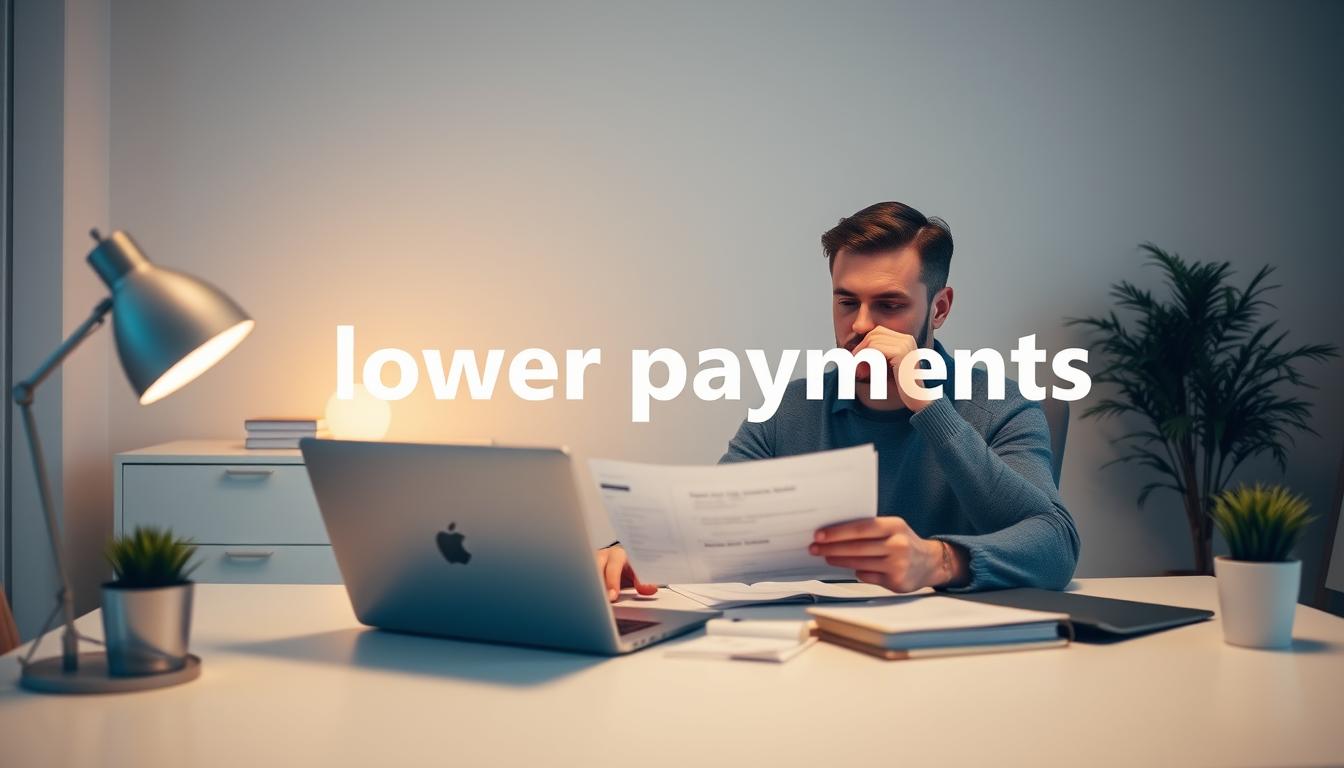Secure Loans for Bad Credit: Flexible Financing Options
Did you know nearly one-third of Americans have a credit score below 580? This makes it hard to get traditional loans for bad credit. But, lenders like Upstart are changing this with flexible financing options that look beyond credit scores.
Upstart uses AI to check things like education, job, and income. This gives a fuller picture of who can get a loan. For example, Upstart’s guaranteed personal loans offer $1,000 to $50,000. You can pay back in 36 or 60 months, with APRs from 6.70% to 35.99%.
Key Takeaways
- Flexible financing options are available for individuals with bad credit.
- Lenders like Upstart use AI-driven assessments to evaluate creditworthiness.
- Loan amounts range from $1,000 to $50,000 with flexible repayment terms.
- No credit score is required for college students or recent graduates.
- Fast funding options are available, with approval as soon as the next business day.
Understanding Bad Credit and Its Impact
Dealing with bad credit can be tough, but knowing its effects is key to getting better. Bad credit isn’t just a small problem. It can really limit your chances of getting loans and credit on good terms.
What is Bad Credit?
Bad credit means you have a low credit score, usually below 580. This score shows how well you handle credit. A low score tells lenders you might be riskier, making it harder to get credit.
Key factors contributing to bad credit include:
- Late or missed payments
- High credit utilization
- Bankruptcy or debt collections
How is Credit Score Calculated?
Credit scores are based on several important factors. Knowing these can help you improve your score.
- Payment History (35%): Your record of on-time payments.
- Credit Utilization (30%): The amount of credit used compared to your credit limit.
- Length of Credit History (15%): The age of your oldest account and the average age of all accounts.
- Recent Inquiries (10%): New credit inquiries and applications.
- Types of Credit Used (10%): A mix of different credit types, such as credit cards, loans, and mortgages.
Common Myths About Bad Credit
There are many wrong ideas about bad credit. Let’s clear up some of these myths:
- Myth: Checking your credit score will lower it. Reality: Soft inquiries, like checking your own score, don’t affect your credit.
- Myth: Bad credit is a permanent mark. Reality: Credit scores can improve over time with responsible financial behavior.
- Myth: You only need to worry about credit scores when applying for a loan. Reality: Your credit score can impact other areas, such as apartment rentals and some job applications.
Types of Loans Available for Bad Credit
Having bad credit doesn’t mean you can’t get a loan. There are many types of loans out there. Each one has its own features and rules. Knowing these can help you choose the right one for you.
Personal Loans
Personal loans are a common choice for people with bad credit. Banks, credit unions, and online lenders offer them. OneMain Financial is one lender that helps those with bad credit. You can use these loans for many things, like paying off debt or buying something big.
Personal loans have some great benefits:
- They offer flexible terms and ways to pay back
- You can use the loan for almost anything
- Making timely payments can help improve your credit score
Secured vs. Unsecured Loans
Loans can be either secured or unsecured. Secured loans need something valuable, like a car or house, as collateral. This makes the loan safer for the lender, which can lead to better terms. Unsecured loans, on the other hand, don’t need collateral. But, they’re riskier for lenders, so they might have higher interest rates or stricter rules.
When deciding between secured and unsecured loans, think about your financial situation. Remember, defaulting on a secured loan can mean losing the collateral you used.
Peer-to-Peer Lending
Peer-to-peer lending platforms like Prosper and Upstart are another option for bad credit borrowers. These platforms match borrowers with investors. This can lead to better interest rates and more flexible terms.
Peer-to-peer lending has its advantages:
- It offers more tailored loan options based on your credit
- It might have lower interest rates than traditional loans
- The application process is often easier and faster online
In summary, people with bad credit have many loan options. By understanding personal loans, secured vs. unsecured loans, and peer-to-peer lending, you can find the best fit for your financial situation.
Benefits of Loans for Bad Credit
Even with bad credit, you can still get the money you need. Bad credit loans offer many benefits. They can help reduce financial stress and improve your financial health over time.
Access to Funds When Needed
Bad credit loans are great for emergencies. They can cover unexpected medical bills, car repairs, or other urgent needs. Experts say, “Having access to funds when you need them most can be a significant relief and help you navigate through tough financial times.”
“Financial flexibility is crucial during emergencies, and bad credit loans can offer that flexibility.”
Opportunity for Credit Improvement
These loans also give you a chance to boost your credit score. By paying on time, you show lenders you can handle debt. This can improve your credit score, making it easier to get loans with better rates in the future. Consistent repayment is key to credit score improvement.
Flexibility in Loan Terms
Lenders often offer flexible terms for bad credit loans. This lets you pick a repayment plan that fits your budget. Flexible loan terms can make a significant difference in your ability to repay the loan without undue hardship.
Knowing the benefits of bad credit loans helps you make better financial choices. It’s a step towards improving your financial health.
How to Choose the Right Lender
Finding the right lender for bad credit loans needs careful planning. There are many choices out there. It’s important to pick wisely to get a loan that fits your financial situation.
Researching Lender Options
Start by researching different lenders. Look at traditional banks, credit unions, and online lenders. Each has its own advantages and disadvantages, as shown in the table below:
| Lender Type | Pros | Cons |
|---|---|---|
| Traditional Banks | Well-known, offers many services | High credit score needed, slow process |
| Credit Unions | Focuses on members, may have better rates | Requires membership, limited services |
| Online Lenders | Fast application, flexible credit checks | Higher interest rates, watch for scams |
Understanding Loan Terms and Conditions
After finding potential lenders, learn about the loan details. This includes the interest rate, how long you’ll pay it back, and any extra fees. As a financial expert says,
“The devil is in the details when it comes to loan agreements. Borrowers must carefully review the terms to avoid unexpected surprises.”
It’s key to read the fine print. A loan might look good at first but have hidden costs that increase the total cost.
Importance of Customer Reviews
Customer reviews give insight into a lender’s reputation and service. Look at reviews on various sites to get a full picture. Focus on comments about customer service, how fast they process loans, and overall satisfaction.

By researching lenders, understanding loan details, and looking at customer reviews, we can make a smart choice. This careful approach ensures we get a loan that helps us now and in the future.
Applying for a Loan with Bad Credit
Applying for a loan with bad credit has several key steps. Knowing these steps can help you get approved. It’s important to understand how to navigate the application process.
Preparing Your Finances
Before you apply for a loan, you need to prepare your finances. Look at your income, expenses, and debts. This helps you know how much you can borrow and repay.
Creating a budget is key. It shows what you can afford and where to cut back. This way, you can save more for loan repayment.
What Documents Are Required?
Lenders need certain documents for your loan application. These include:
- Proof of income (pay stubs, W-2 forms)
- Identification (driver’s license, passport)
- Bank statements
- Information about your debts and assets
Having these documents ready can make the application process smoother. It also increases your chances of getting approved.
| Document Type | Description | Example |
|---|---|---|
| Proof of Income | Documents showing your current income | Pay stubs, W-2 forms |
| Identification | Documents verifying your identity | Driver’s license, Passport |
| Bank Statements | Recent statements showing your financial activity | Monthly bank statements |
Steps in the Application Process
The loan application process has several steps. These include:
- Pre-qualification: An initial check of your creditworthiness.
- Application submission: You provide detailed financial information.
- Review and approval: The lender checks your application.
- Loan disbursement: You get the loan if approved.
Knowing these steps can help you prepare. It may improve your chances of getting a loan, even with bad credit.
Alternatives to Traditional Loans
For those with bad credit, looking into other loan options can help. Traditional banks often have strict rules that are hard to meet, making it tough for those with credit issues.
Credit Unions
Credit unions are owned by their members and offer personalized service. They have more flexible lending rules than banks. This means they might give better rates and terms to those with bad credit.
Joining a credit union can be smart for those with bad credit. They look at more than just credit scores when lending.
Community Banks
Community banks are a good choice for loans with bad credit. They know their local area well and understand their customers’ needs.
These banks might offer more flexible loan terms. They’re also more open to working with people who have less-than-perfect credit.
Online Lenders
Online lending platforms have grown a lot, offering more options for bad credit. They use alternative credit scoring models to look at more financial data. This makes it easier for those with bad credit to get loans.
But, it’s important to check the terms and conditions of online lenders. Some might charge higher interest rates or have less favorable repayment terms.
| Lender Type | Interest Rates | Flexibility | Credit Score Consideration |
|---|---|---|---|
| Credit Unions | Competitive | High | Holistic Approach |
| Community Banks | Variable | Moderate | Considerate of Local Factors |
| Online Lenders | Variable, sometimes high | High | Alternative Scoring Models |
Looking into other loan options can give bad credit individuals a second chance. Whether it’s through credit unions, community banks, or online lenders, there are many choices.
Tips for Managing Bad Credit Loans
Getting a loan with bad credit is a big step. Now, you need to manage it well. This is key to avoid more financial trouble and start fixing your credit score.
Making Timely Payments
Making payments on time is very important. Late payments can hurt your credit score more and cost extra fees. To stay on track, set up automatic payments or reminders.
Benefits of Timely Payments:
- Avoid late fees and penalties
- Reduce the risk of further credit score damage
- Demonstrate responsible financial behavior
Creating a Budget
Creating a budget is crucial for managing your loan. First, track your income and expenses to see where your money goes. Then, plan your spending to make sure you can pay your loan on time.
Budgeting Tips:
- Prioritize essential expenses like rent, utilities, and food
- Set aside money for loan repayment
- Find ways to cut back on non-essential spending
Avoiding New Debt
It’s important to avoid new debt while paying off your loan. Taking on more debt can make it harder to manage your current loan. Be careful with credit cards and don’t apply for new loans unless you really need to.
Strategies to Avoid New Debt:
- Only use credit cards for necessary purchases
- Don’t apply for many credit cards or loans at once
- Consider cutting up credit cards or freezing them to stop impulse buys
By following these tips, you can manage your bad credit loan well. This will help you move towards a better financial future. Remember, it’s not just about paying off the loan. It’s also about improving your credit score and financial stability.
The Role of Co-Signers in Bad Credit Loans
Co-signers are key in bad credit loans. They add security for lenders. Having a co-signer can greatly boost our chances of getting a loan.
Advantages of Having a Co-Signer
A co-signer with good credit can help us get better loan terms. This includes lower interest rates. Lenders feel more secure with two people to repay the loan.
- Improved Approval Chances: A co-signer makes lenders more likely to say yes.
- Better Loan Terms: We might get more favorable terms, like lower interest rates.
Potential Risks Involved
Co-signers come with risks. If we can’t pay back the loan, they’ll be on the hook. This can harm our relationship with them.
- The co-signer’s credit score can drop if we default.
- Our bond with the co-signer might suffer due to financial stress.
Finding a Suitable Co-Signer
To find a good co-signer, look for someone with a solid credit history. This is often a family member or close friend.
Be open about our financial situation and the loan terms when asking someone to co-sign. Having a clear repayment plan can ease their worries.

Avoiding Predatory Lenders
When you’re looking for a loan with bad credit, watch out for predatory lenders. They take advantage of people who are in a tough spot. This can trap you in a cycle of debt that’s hard to get out of.
Signs of a Predatory Loan
Predatory loans have some key signs that set them apart from real loans. Look out for:
- Extremely High Interest Rates: Rates that are way above what’s normal.
- Hidden Fees: Fees that aren’t clear or are hidden in small print.
- Unfavorable Terms: Terms that don’t help you, like penalties for paying off early.
- Aggressive Collection Practices: Lenders who push too hard to get their money back.
What to Do if You’re Targeted
If you think you’re being targeted by a predatory lender, here’s what to do:
- Carefully Review the Loan Terms: Make sure you understand everything before you sign.
- Seek Advice: Talk to a financial advisor or credit counselor.
- Report Suspicious Activity: Tell the right authorities about it.
Reporting Fraudulent Practices
Telling on predatory lending is key to stopping others from getting hurt. You can report it to:
- Consumer Financial Protection Bureau (CFPB): A government group that watches over financial products for consumers.
- Federal Trade Commission (FTC): An agency that fights unfair business practices.
- Your State’s Attorney General Office: Local officials who can look into and punish predatory lenders.
Knowing the signs of predatory loans and how to report them helps keep you and others safe. It stops these bad lenders from taking advantage of people.
Building Your Credit Score for the Future
Securing loans with bad credit can be tough. But, focusing on building a stronger financial base is key. Improving your credit score opens doors to better loan terms and lower interest rates later on.
Effective Strategies for Improvement
Start by making timely payments and cutting down your debt. This shows you’re financially responsible. Also, check your credit reports often to spot and fix any mistakes that might hurt your score.
Staying Informed
Learning about credit is crucial. Use trusted sources and tools to understand credit management better. As you improve your score, you’ll find it easier to get loans and access other financial benefits.









